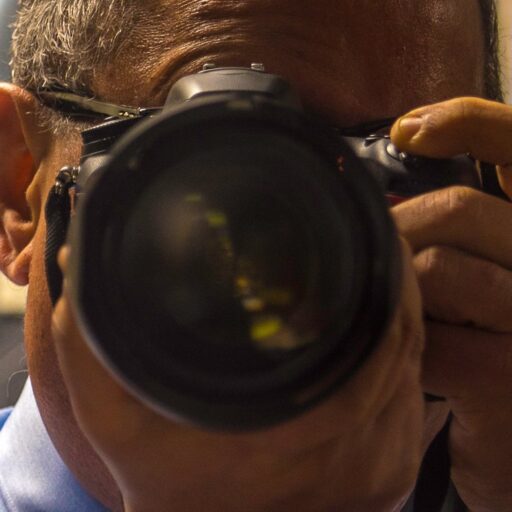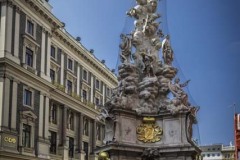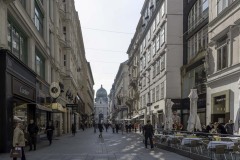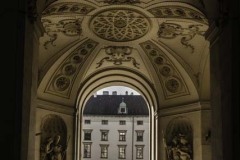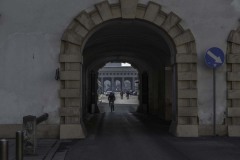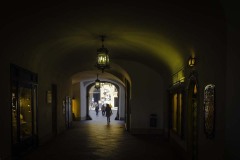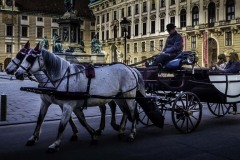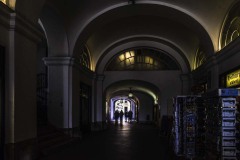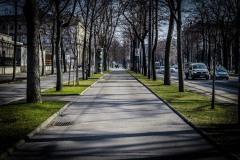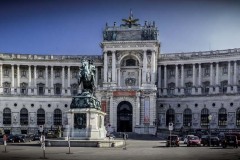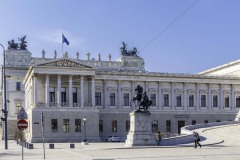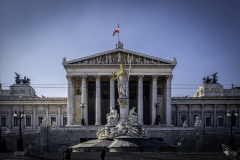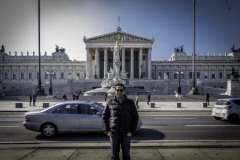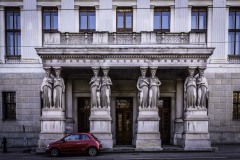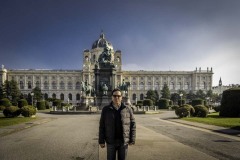Vienna, the capital city of Austria, is known for its rich history, stunning architecture, and cultural attractions. With its grand palaces, charming coffeehouses, and world-class museums, Vienna is a city that offers something for everyone. In this blog, we will explore some of the top sights and experiences that make Vienna a must-visit destination.
One of the most iconic landmarks in Vienna is the Schönbrunn Palace, a UNESCO World Heritage site. This 1,441-room palace was the summer residence of the Habsburg monarchs and is a testament to their wealth and power. Visitors can tour the palace’s lavishly decorated rooms, stroll through the extensive gardens, and even catch a glimpse of the Vienna Zoo, the oldest zoo in the world, located on the palace grounds.
Another impressive palace in Vienna is the Hofburg Palace, which was the principal imperial palace of the Habsburgs. The palace now houses several museums, including the Imperial Treasury, which features the Habsburgs’ crown jewels and other precious artifacts. Visitors can also see the stunning Spanish Riding School, where Lipizzaner horses are trained in classical dressage.
Vienna is also known for its coffeehouse culture, which dates back to the 17th century. These coffeehouses were once the meeting places of artists, intellectuals, and politicians and were important centers of Viennese social life. Today, many of these coffeehouses still exist and offer a cozy and relaxed atmosphere to enjoy a cup of coffee and a slice of cake. Café Central, Café Sacher, and Café Demel are some of the most famous coffeehouses in Vienna.
Vienna is also home to several world-class museums. The Kunsthistorisches Museum, or Museum of Fine Arts, houses an impressive collection of artwork, including works by Vermeer, Bruegel, and Rubens. The Belvedere Palace is another museum that should not be missed, with its collection of Austrian art from the Middle Ages to the present day, including Gustav Klimt’s famous painting, “The Kiss.”
Lastly, Vienna is a city that loves its music. The Vienna State Opera is one of the most famous opera houses in the world and hosts over 300 performances each year. The Vienna Philharmonic Orchestra, one of the world’s top orchestras, also performs in the city’s many concert halls.
In conclusion, Vienna is a city that has something for everyone. From its grand palaces and world-class museums to its coffeehouse culture and love of music, Vienna is a destination that should be on every traveler’s list. Whether you are a history buff, an art lover, or a foodie, Vienna is a city that will capture your heart and leave you with unforgettable memories.
The History Of Vienna
The history of Vienna dates back to the Roman Empire, when it was a small settlement called Vindobona. It was strategically located on the Danube River, which made it an important trading post and military base. The Romans built a fortification and a civilian town, and Vindobona flourished for several centuries.
After the fall of the Roman Empire, Vienna was settled by various Germanic tribes, including the Bavarians and the Slavs. In the 9th century, the Babenberg dynasty established Vienna as their capital city and built a castle, which later became the Hofburg Palace. Vienna continued to grow in importance as a political and economic center, and in the 12th century, it was granted a city charter.
In the 13th century, Vienna became a free imperial city, which meant that it was directly controlled by the Holy Roman Emperor. This led to a period of economic and cultural growth, and Vienna became known for its skilled craftsmen, musicians, and artists.
In the 15th century, Vienna faced several challenges, including invasions by the Ottomans and the outbreak of the Black Death. However, the city recovered and entered a new era of prosperity in the 16th and 17th centuries, during the reign of the Habsburg dynasty. Under the Habsburgs, Vienna became the capital of the Holy Roman Empire and the center of a vast empire that included much of Central Europe.
During the 18th and 19th centuries, Vienna continued to grow and modernize. The city became a center of the Enlightenment, and many famous thinkers and artists, including Mozart, Beethoven, and Freud, lived and worked in Vienna during this time. The city also experienced significant growth in industry, trade, and transportation.
In the 20th century, Vienna was marked by two world wars, which had a profound impact on the city. After World War I, Austria became an independent republic, and Vienna became its capital once again. However, the country was annexed by Nazi Germany in 1938, and Vienna became a center of Nazi power. During World War II, the city was heavily bombed, and many of its historic buildings were destroyed.
After the war, Vienna was occupied by the Allied powers and divided into four zones. The city was rebuilt, and in 1955, Austria regained its independence. Vienna once again became a cultural and economic center, and it played an important role in the European integration process. Today, Vienna is a modern and vibrant city, known for its rich history, stunning architecture, and cultural attractions.
What you can see in Vienna
Vienna is a city that offers a wide range of sights and experiences for visitors. Here are some of the top things to see and do in Vienna:
- Schönbrunn Palace: This stunning palace was once the summer residence of the Habsburgs and is a must-see for any visitor to Vienna. The palace is surrounded by beautiful gardens and offers fantastic views of the city.
- Hofburg Palace: This impressive palace was the principal imperial palace of the Habsburgs and now houses several museums, including the Imperial Treasury and the Spanish Riding School.
- St. Stephen’s Cathedral: This beautiful cathedral is the most important religious building in Vienna and is a symbol of the city. Visitors can climb to the top of the tower for panoramic views of Vienna.
- Belvedere Palace: This Baroque palace houses an impressive collection of Austrian art, including Gustav Klimt’s famous painting “The Kiss.”
- Vienna State Opera: This world-famous opera house hosts over 300 performances each year and is a must-visit for any music lover.
- Naschmarkt: This bustling market offers a wide range of fresh produce, spices, and other goods, as well as a variety of international street food.
- Prater: This large park is home to the famous Wiener Riesenrad ferris wheel, as well as a variety of other attractions, including roller coasters, bumper cars, and a planetarium.
- Vienna Zoo: Located on the grounds of the Schönbrunn Palace, this is the oldest zoo in the world and is home to over 700 species of animals.
- Kunsthistorisches Museum: This museum houses an impressive collection of artwork, including works by Vermeer, Bruegel, and Rubens.
- Coffeehouses: Vienna is famous for its coffeehouse culture, and there are many traditional coffeehouses throughout the city where visitors can enjoy a cup of coffee and a slice of cake while soaking up the atmosphere.
These are just some of the many sights and experiences that Vienna has to offer. Whether you’re interested in history, art, music, or food, Vienna is a city that has something for everyone.
The best time of the year you can visit Vienna
The best time of year to visit Vienna depends on your preferences and what you want to experience during your trip. Here is a breakdown of the different seasons in Vienna:
- Spring (March – May): Spring is a lovely time to visit Vienna, as the weather starts to warm up and the parks and gardens begin to bloom. The famous cherry blossom trees in the city’s parks are particularly beautiful in April. The downside is that spring can be quite rainy, so it’s a good idea to bring an umbrella.
- Summer (June – August): Summer is the peak tourist season in Vienna, and for good reason. The weather is warm and sunny, and there are many outdoor events and festivals to enjoy, such as the Vienna Jazz Festival and the Danube Island Festival. However, the crowds can be quite intense, and prices for accommodation and attractions are higher.
- Fall (September – November): Fall is a beautiful time to visit Vienna, as the leaves change color and the weather cools down. The city’s many museums and cultural attractions are a great way to spend a rainy day, and there are plenty of wine festivals and other events to enjoy. The downside is that the days start to get shorter, and the weather can be unpredictable.
- Winter (December – February): Vienna is known for its charming Christmas markets and festive atmosphere during the winter months. The city is also home to many classical music concerts and opera performances during the holiday season. However, it can be quite cold and snowy, so it’s important to dress warmly.
Overall, the best time of year to visit Vienna depends on your interests and preferences. If you’re looking for warm weather and outdoor events, summer is a great time to go. If you want to experience the city’s holiday spirit, winter is the perfect time to visit.
Restaurant, show and nightlife in Vienna
Vienna has a vibrant restaurant scene, offering a wide range of cuisine from traditional Austrian dishes to international fare. Here are some recommendations for restaurants, shows, and nightlife in Vienna:
Restaurants:
- Figlmüller: This restaurant is famous for its schnitzel, a traditional Austrian dish made with breaded and fried meat. Figlmüller’s schnitzel is large enough to share, and the restaurant has a cozy, rustic atmosphere.
- Plachutta: This restaurant specializes in traditional Viennese cuisine, including beef broth, goulash, and Tafelspitz, a boiled beef dish. The restaurant has several locations throughout the city, each with a different atmosphere.
- Naschmarkt: This bustling market is a great place to sample a variety of international cuisine. There are many stalls selling street food, as well as restaurants and cafes with outdoor seating.
Shows:
- Vienna State Opera: The Vienna State Opera is one of the most famous opera houses in the world, and it hosts over 300 performances each year. Visitors can enjoy everything from classic operas to modern productions.
- Musikverein: This concert hall is home to the Vienna Philharmonic Orchestra, one of the world’s top orchestras. The Musikverein hosts a variety of classical music concerts throughout the year.
- Volkstheater: This theater offers a mix of classic and contemporary plays, as well as dance performances and concerts. The theater has a relaxed, informal atmosphere and is popular with locals.
Nightlife:
- Bermuda Triangle: This area in the city center is known for its lively nightlife, with many bars, clubs, and restaurants. It’s a popular spot for young people and is especially busy on weekends.
- Flex: This club is one of the most famous in Vienna, hosting a variety of live music events and DJs. The club has a relaxed, alternative atmosphere and is popular with locals and tourists alike.
- Prater: This large park is home to many bars and restaurants, as well as the famous Wiener Riesenrad ferris wheel. It’s a great place to enjoy a drink and a view of the city.
is probably one of the most beautiful cities in the I ever visited. It is the center of arts and classical music and it offers things to do for several days. Vienna has even won the title of the world’s most livable city I do not know before or after Melbourne.
Vienna is known as the “City of Music” due to its musical legacy, as many famous classical musicians such as Beethoven and Mozart called Vienna home. Vienna is also said to be the “City of Dreams”
It is in the northeastern corner of Austria, between the foothills of the Alps and the Carpathians, where the Danube (German: Donau), Europe’s second longest river, has cut its course through the mountains. The city is situated alongside the river, most of it on the right bank.
